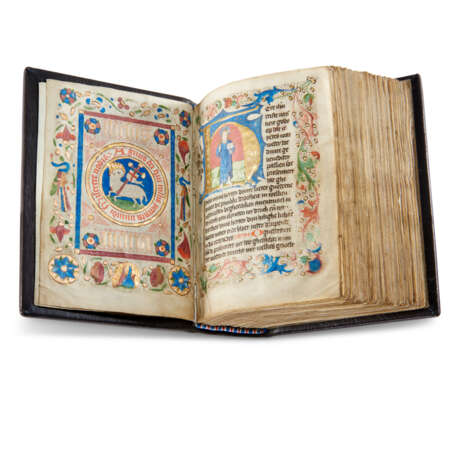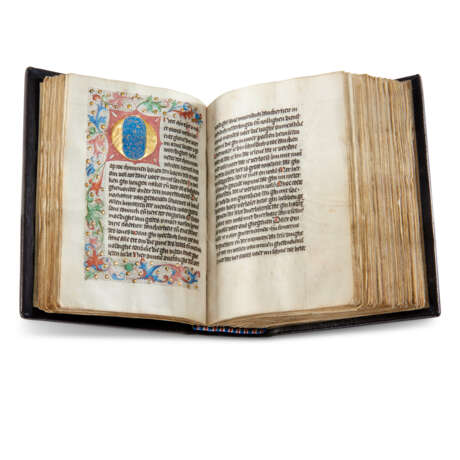ID 993204
Лот 56 | IJzendoorn convent of Franciscan Tertiaries dedicated to St Mary Magdalene
Оценочная стоимость
£ 12 000 – 18 000
Prayerbook, in Dutch, illuminated manuscript on vellum [eastern north Netherlands, c.1475]
An engagingly illuminated devotional manuscript produced at the IJzendoorn convent of Franciscan Tertiaries in Zutphen.
140 x 98mm. 241 leaves, modern pencilled foliation on every tenth leaf has numbered f.81 as 80 but f.170 is correctly numbered, text apparently continuous despite stubs after ff. 11, 13, 17, 20 lines, ruled space: 89 x 60 mm, rubrics in red, text capitals touched with red, one- and two-line initials alternately in red or blue, large initials in blue with reserved patterns extensively flourished in red, 11 large illuminated initals, one historiate, with three-sided borders, two full-page miniatures with borders (slight rubbing to some illuminated initials and borders including f.3, lower corner of margin excised f. 16). Wooden boards, stained, with Cross in roundel, rebacked in leather, metal clasp (wear to edge of covers by clasp).
Provenance:
(1) The language shows some distinctively eastern forms of Middle Dutch; the flourishing and illumination associate this manuscript with a group produced in the east of the northern Netherlands that awaits precise localisation. The borders are very close to those in a book of hours in the Amsterdam University Library, I G 54, while the flourishing is by the same hand as that in a prayerbook in the Deventer Stads- of Athenaeum-bibliotheek, 101 E 17, see A. Korteweg, Kriezels, aubergines en takkenbossen, 1992, nos 128 and 129. The group, where decoration does not usually include miniatures, was probably produced by a monastic community or house of the Brethren of the Common Life. The miniatures also originated in the eastern Netherlands, with the Franciscan nuns of IJzendoorn by Zutphen.
(2) Jakob Reefsen or Jacobus Revius (1586-1658): 'Sum Jacobi R. Reuij' on first endleaf. The son of Ryck Reefsen, Revius presumably used the initial R for his patronymic. He was an important theologian, Hebrew scholar, historian (author of Daventriae illustratae, a history of his home town of Deventer) and poet: seven of his poems are still in use as hymns in the Dutch Calvinist Church. The Dutch texts of this prayerbook would have interested him both as church historian and writer in the vernacular, while its Christocentric prayers and limited illustration would have made it comparatively acceptable to a follower of Calvin.
(3) Victor von Stedingk (1751-1823), Swedish nobleman and naval officer: his armorial bookplate and signature inside front cover.
(4) Christie's, 8 June 2011, lot 10.
Content:
A sequence of prayers on the Passion, ff.1-54: Henry Suso, 100 Articles of the Passion ff.1-23v, prayer on the passion to be said at the liturgical hours ff.24-33v, Arnulph of Leuven, prayers on the wounded parts of Christ's body ff.33v-41, prayers on the wounds of Christ, ff.41-47, third of Thomas à Kempis's Prayers on the Passion, ff.47v-54; a sequence of prayers to God the Father or Christ ff.54-167v, including prayers attributed to St Augustine ff.59-62, St Jerome f.81-82v, St Anselm ff.82v-83, St Thomas Aquinas ff.85-87, St Francis on the Five Wounds of Christ ff.87-91, 33 petitions for the 33 years Christ lived on earth ff.104-113, on the Ascension ff.124-131v, on the birth of Christ ff.133v-140v, for the love of God ff.143v-146v, attributed to St Bernard ff.149v-162v, to St Augustine ff.162v-167v; a sequence on the Sacrament ff.168-209v, including St Jerome ff.168-173v, St Ambrose ff.179-180v; on Christ ff.210-213v; prayers to the Virgin ff.214-241v, including her eight joys f.231v.
The emphasis on Christ suggests that the book was made for, and probably by, a follower of the Devotio moderna, the movement that stressed the importance of the direct relationship between the individual and God, who could be approached through the humanity of Christ, an idea most famously expressed through Thomas à Kempis's Imitation of Christ. The scribe had to make several corrections as he wrote and a few further corrections have been added to the margins.
Illumination:
The extensive flourishing makes especially pleasing use of leaf and plant motifs; there is one red initial flourished in violet on f.207v. The colourful acanthus and bold gold disks of the illuminated borders were popular across the northern Netherlands but are distinguished in this group of manuscripts by their sinuous rhythms and accompanying dotted penwork. On f.214 the acanthus curl around a burnished gold bar in the outer and lower margins. The gold of the large initials is strikingly enhanced by their deep pink surrounds and infills of blue or deep pink with delicate floral and foliate patterns in camaïeu d'or, with the addition of pink and gold flowers and green leaves on f.59. It has yet to be established where these illuminators were active within the eastern part of the northern Netherlands: they could have obtained the full-page miniatures very locally or imported them from further afield.
The miniatures can be localised to Zutphen, to the IJzendoorn convent of Franciscan Tertiaries dedicated to St Mary Magdalene, by comparison with a Missal for the use of IJzendoorn, now in the library of the St Walburgiskerk, Zutphen, ms 3. The miniatures and their borders are directly comparable with those in two books of hours, The Hague, KB, ms 77 L 58, and Nuremberg, Germanisches Nationalmuseum, ms 18432. Their style derives from that of the so-called Masters of Margriet Uutenham, who were almost certainly nuns of the Convent of Bethany at Arnhem, a house of Augustinian canonesses. Although women could be involved in book production in the secular world, convents often provided training and resources that women would have found difficult to access elsewhere. The Zutphen Convent may have been inspired by Bethany's example to supplement their revenues through book and miniature production. Bound in at the front of the volume, the full-page miniatures have nearly symmetrical borders, suggesting that they were made as devotional images with the potential for independent use (see Kathryn M. Rudy, 'Manuscripts from Zutphen, Lamb of God roundels, and a new iconography of penance', Quaerendo 41, 2011, pp.360-372).
The full-page miniatures are: diagrammatic representation of the five wounds of Christ f.1v; the Lamb of God f.2v. The historiated initial is of Christ, f.2. The large illuminated initials and borders are on ff.3, 47v, 54, 59, 64v, 76v, 87, 124, 149v, 201, 214.
Special notice
No VAT is payable on the hammer price or the buyer's premium for this lot. Please see the VAT Symbols and Explanation section of the Conditions of Sale for further information
| Место происхождения: | Западная Европа, Европа, Нидерланды |
|---|---|
| Категория аукционного дома: | Манускрипты Средневековья и Ренессанса |
| Место происхождения: | Западная Европа, Европа, Нидерланды |
|---|---|
| Категория аукционного дома: | Манускрипты Средневековья и Ренессанса |
| Адрес торгов |
CHRISTIE'S 8 King Street, St. James's SW1Y 6QT London Великобритания | |
|---|---|---|
| Предосмотр |
| |
| Телефон | +44 (0)20 7839 9060 | |
| Комиссия | see on Website | |
| Условия использования | Условия использования |






